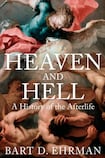
Bart D Ehrman’s latest work of popular scholarship is boldly subtitled A History of the Afterlife, but it is a history in only the most rudimentary sense. An unsatisfying read, Heaven and Hell is more of a bulked-up timeline, which evades close historical work and nuanced contextual thought by either dismissing the possibility of such work or wilfully misunderstanding the nature and function of literary texts. If readers are seeking A History of the Afterlife, they would be well-advised to look elsewhere.
Ehrman’s book, with its lavish cover and catch-all title, is certainly an appealing prospect, and could have achieved far more within its remit. On reading the work, it is hard not to think that its failures can be attributed to laziness – certainly, no book published for a scholarly audience could get away with such looseness or generalisation, and no book for a popular audience should be afforded such slackness. Rather, the lack of evidence of in-depth research which this book conveys, and Ehrman’s willingness to simply relate and explain (in the loosest terms) a series of texts, acts as though the general reading public is incapable of grasping rigorous argument.
Clearly this is not the case. Other (better) historians writing for popular audiences have done well to trust their readers’ intelligences, marrying detail and insight with an accessible prose style.
The book focuses solely on the Christian afterlife, and begins with the contentious claim that Christianity is “the most historically significant and culturally influential religion in the world”. Though it begins with the Greeks, and then the Romans, its sense of a non-western tradition is limited, and it does not really account for cross-cultural inflections or the popular conceptions of the afterlife which existed outside the doctrine of various established churches.
Of course, literary texts do not 'provide their own interpretations', a strictly 'true' reading that trumps all other
That most important facet of understandings of the afterlife – folk belief – is hardly mentioned at all, though it is clear that for most of history people have developed a more complex and non-normative understanding of the afterlife than that passed down to them in Sunday sermons.
When posing the question to himself of how we might come to understand popular views of the afterlife in largely illiterate societies, Ehrman simply states that, because non-elites did not write, “how can we know what they thought and believed?” Thus, he places his “get out of jail free” card on the table, smiles sagely, and moves on.
Material culture – the history of material objects – is barely considered, because “the problem with material remains is that they are silent: they don’t provide their own interpretations”. This, Ehrman argues, is why they are less useful to his argument than literary and theological texts.
Of course, literary texts do not “provide their own interpretations”, a strictly “true” reading that trumps all other; rather, readers provide interpretations, and Ehrman is just one reader, and cannot claim literary texts as the source of a single, undeniable historical truth.
Context
This is particularly problematic for Heaven and Hell, mainly because Ehrman’s “history” depends largely on moving chronologically from one text to another, relating their narratives to the reader. He rarely stops to consider details of context, or the particular historical situations from which the ideas of the afterlife conveyed arose.
One thing that would have been interesting to consider more fully is the efficacy of ideas of the afterlife for social control and cultural purposes
Politics, imperialism, the difficulties of translation, class, and folk narratives, are considered in only the most lax terms. In one instance, he writes, “It is hard to see what among the enormous changes in the political, social, and cultural worlds between seventh-century Greece and first-century Rome might have effected the shift in thinking”.
What Ehrman seems to skirt over, here, is that the role of the historian is to interrogate, to inquire, and to try (through research) to fill these gaps. It seems a bold move to write a history of the afterlife and then, at inconvenient moments, turn to the reader and claim that history, for a period of seven centuries, is a void about which things cannot be determined.
One thing that would have been interesting to consider more fully is the efficacy of ideas of the afterlife for social control and cultural purposes: why does one idea become endorsed over another, and out of which sociopolitical matrix does that endorsement come? Whose purposes does the afterlife (in whatever conception) serve?
If one is to attempt a sweeping, grand narrative encompassing the whole span of the history of the Christian afterlife, one must be prepared to think rigorously, and to put in significant time and thought. Ehrman, on the other hand, publishes his books roughly two years apart, and in this instance does a disservice to the complexity and interest of his subject.








